Table of Contents
Updated October 16, 2025 – This article has been revised to include up-to-date definitions, best practices, and future trends.
The rapid expansion of SaaS shows no signs of slowing in 2025. On average, the typical enterprise now manages about 651 SaaS apps, often with limited oversight. This represents a nearly 20% increase compared to 2023. While growth can drive productivity, it also introduces risks. Without a clear governance strategy, organizations face rising costs, shadow IT, compliance gaps, and increased exposure to data breaches.
SaaS governance establishes the framework necessary to manage applications effectively. By setting policies for how SaaS is discovered, acquired, secured, and measured, businesses reduce waste, protect sensitive data, and ensure every investment delivers value.
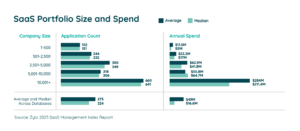
What Is SaaS Governance?
SaaS governance refers to the processes and practices organizations use to identify, control, and manage subscription-based software. It defines how applications are purchased, monitored, secured, and retired throughout their lifecycle.
In 2025, governance is about more than cost reduction. It is a framework that balances financial efficiency, compliance, and security while maintaining flexibility for innovation. With effective software governance in place, companies gain full visibility into their portfolios, mitigate risk, and adapt more quickly to emerging technologies.
Watch the video for a more detailed rundown of the definition and how to implement governance.
Why SaaS Governance Matters in 2025
Organizations today run on SaaS, but the benefits of speed and flexibility can be lost without clear oversight and management. Strong governance ensures that software supports business goals, rather than creating hidden risks. The importance of SaaS governance becomes clearer when considering its impact on cost, security, compliance, and employee productivity.
Key areas that highlight the importance of SaaS governance include:
- Financial efficiency and cost control
- Security and compliance protection
- Employee experience and productivity
- Strategic alignment with business objectives
Financial efficiency and cost control
Governance provides the visibility needed to identify redundant apps, unused licenses, and unapproved purchases. With SaaS costs rising in 2025, financial efficiency depends on managing spend in real time and aligning budgets with actual usage. Total SaaS spend now averages a shocking $4,830 per employee, resulting in a 21.9 % increase year-over-year.
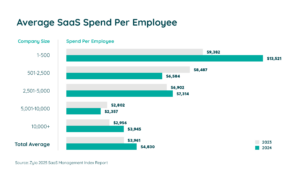
Security and compliance protection
Unmonitored applications introduce significant risk.
- Analysts estimate that nearly half of SaaS-related security events in 2025 stemmed from shadow IT and unsanctioned apps.
- Without centralized management of SaaS, Gartner predicts organizations are 5X more susceptible to cyber incidents.
- According to IBM’s 2025 Cost of a Data Breach Report, the average cost of a data breach is $4.4M.
SaaS governance reduces the chance of data leaks and compliance failures by ensuring security reviews, vendor vetting, and access policies are consistently applied.
Employee experience and productivity
Employees need quick access to approved tools. Governance structures streamline app provisioning, reduce shadow IT, and make it easier for teams to adopt software that improves their work without creating risk.
Strategic alignment with business objectives
Every SaaS purchase should align with the broader business objectives. Governance frameworks establish processes for evaluating new tools and retiring outdated ones, ensuring alignment with long-term priorities.
SaaS Governance Models to Consider
No two organizations manage SaaS the same way. The right governance model depends on company size, culture, and risk tolerance. Choosing a model that fits ensures both oversight and flexibility.
The primary SaaS governance models include:
- Centralized model
- Decentralized model
- Hybrid model (Freedom within a Framework)
Centralized model
A centralized governance model places full responsibility in the IT or procurement team. This approach delivers strong visibility, consistent security controls, and cost optimization, but it may reduce flexibility for departments that want faster access to new tools.
Decentralized model
In a decentralized model, departments or business units manage their own SaaS applications. This structure provides agility but often results in shadow IT, redundant apps, and inconsistent security practices.
Hybrid model
The hybrid approach combines centralized oversight with decentralized flexibility. Core IT establishes governance standards for security, procurement, and compliance, while departments retain the freedom to select tools that meet their needs within those guardrails.
Evolving Your SaaS Governance Framework for the Digital Workplace
Learn MoreCommon SaaS Governance Challenges
Even with the best frameworks, organizations face obstacles when rolling out governance programs. Understanding the most common challenges makes it easier to plan solutions and avoid setbacks.
Key SaaS governance challenges include:
- Lack of visibility into the full application portfolio
- Shadow IT and unapproved software
- License sprawl and wasted spend
- Inconsistent security and compliance practices
Lack of visibility into the full application portfolio
Many organizations underestimate the number of SaaS applications their employees are using. Without complete visibility, companies risk overspending and missing potential security issues.
Shadow IT and unapproved software
Employees often adopt tools outside of approved channels. While this may solve short-term needs, it creates blind spots for IT and compliance teams that can introduce long-term risk.
License sprawl and wasted spend
Duplicate applications and unused licenses unnecessarily drive up costs. In 2025, the average organization wastes $21M on unused licenses alone. Rightsizing licenses and consolidating tools is essential to achieve financial efficiency.
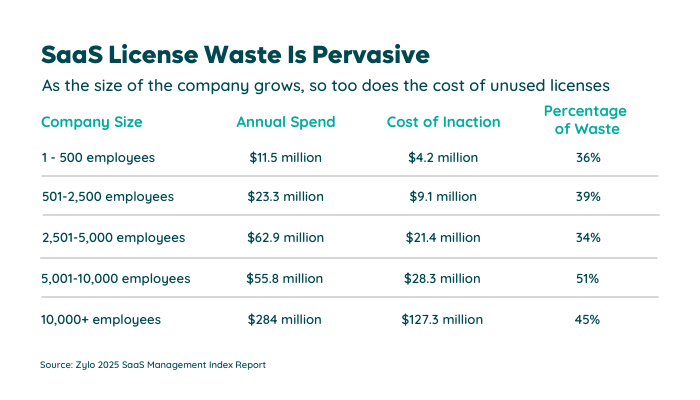
Inconsistent security and compliance practices
When apps are managed inconsistently across departments, security and compliance gaps widen. Governance frameworks must standardize reviews, contracts, and monitoring to keep data protected.
Follow These SaaS Governance Best Practices for 2025
Governance is only effective when translated into consistent action. By following established best practices, organizations can establish a SaaS governance framework that strikes a balance between oversight and agility. The following steps reflect both proven methods and emerging trends shaping SaaS governance in 2025.
Key best practices include:
- Identify and monitor your saas inventory
- Leverage ai for smarter governance
- Integrate ai-native saas applications responsibly
- Build sustainability into software procurement
- Determine the right approach for your organization
- Establish a process for managing saas acquisitions
- Standardize your software
- Offer employees an application catalog
- Understand your security posture
- Rightsize and rationalize your portfolio
- Communicate transparently with the company
- Measure program effectiveness
#1 Identify and Monitor Your SaaS Inventory
Zylo data shows that organizations underestimate their SaaS spend and portfolio size by 3X and 1.7X, respectively. With an average of 7 new apps entering an organization’s stack every 30 days, those metrics can balloon quickly. In fact, this equates to 33% portfolio growth annually.
Visibility is the foundation of SaaS governance. Continuously track applications across the organization to:
- Uncover shadow IT
- Eliminate duplicate tools
- Ensure contracts align with actual usage
Using real-time discovery tools, you can reduce blind spots and support smarter decision-making.
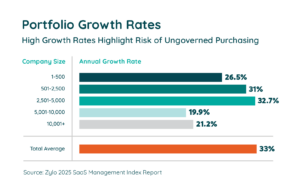
#2 Leverage AI for Smarter Governance
AI is reshaping SaaS Management in 2025. Machine learning models can:
- Detect unusual license activity
- Highlight potential compliance risks
- Forecast usage trends more accurately than manual methods
When you integrate AI into governance, you get faster insights, proactive cost savings, and stronger protection against emerging threats as SaaS portfolios expand.
#3 Integrate AI-Native SaaS Applications Responsibly
As more vendors launch AI-native platforms, governance frameworks must adapt. These tools often process sensitive data and rely on opaque algorithms, creating new compliance and ethical considerations.
To leverage AI innovation while mitigating associated risks, establish clear policies for:
- Data use
- Vendor accountability
- Bias monitoring
#4 Build Sustainability into Software Procurement
Sustainability is becoming a board-level priority in 2025. SaaS governance can support environmental, social, and governance (ESG) goals by factoring:
- Energy efficiency
- Vendor sustainability practices
- Long-term viability into procurement decisions
Include sustainability in governance criteria to strengthen corporate responsibility while future-proofing your software portfolio.
#5 Determine the Right Approach for Your Organization
Every business requires a governance model tailored to its size, culture, and risk profile. Some will favor centralized oversight for consistency, while others opt for hybrid structures to strike a balance between control and flexibility. Clarify your approach early to make it easier to set policies that employees will follow.
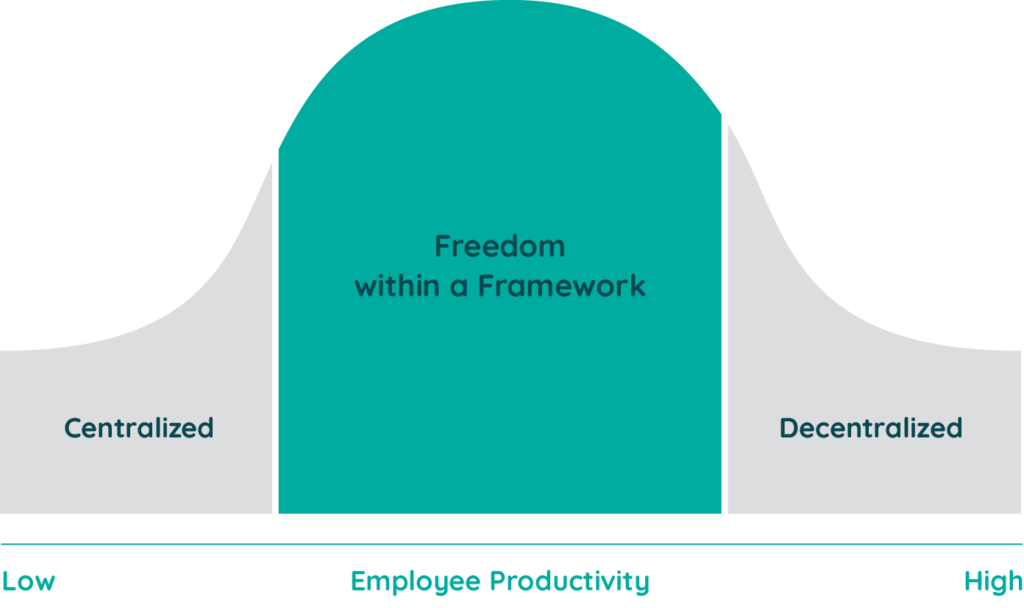
Where does your organization fall on the spectrum? Find out by taking this governance quiz.
#6 Establish a Process for Managing SaaS Acquisitions
Uncontrolled purchases drive cost overruns and security issues. Your governance program should define clear approval workflows for acquiring new software, including:
- Vendor vetting
- Contract negotiation
- Security checks
In additional to establishing a process, these tactics can help:
- Establish a review board
- Put a limit on expense reimbursements – or ban expense reimbursements altogether
- Put a purchase moratorium in place until governance is implemented more fully
A structured process lets you ensure new tools add value without creating hidden risks.
#7 Standardize Your Software
Our next best practice for SaaS governance is application standardization. That means establishing a set of preferred software for your business. It’s often the first big step toward long-term governance of your SaaS stack.
A few benefits of identifying preferred software helps:
- Alleviate IT’s administrative burden
- Cut costs
- Reduces shadow IT
- And more!
Standardizing your technology involves getting visibility into all SaaS in your stack, identifying a list of standard software titles, and rationalizing your portfolio to reduce the number of apps within it. Adobe is a perfect case study of how enterprises can standardize their technology to unlock its benefits.
Adobe Drives Innovation and Massive Savings with Zylo
In the past 4 years, Adobe has rapidly scaled from $9B to $18B. This growth has made an already complex environment even more complex. Learn how they leveraged Zylo to get complete visibility into their SaaS portfolio, unlock millions in cost savings and avoidance and improve the employee experience.
#8 Offer Employees an Application Catalog
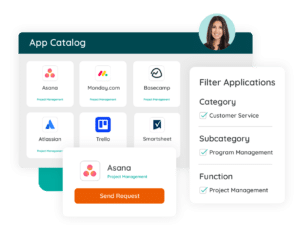
Employees are more likely to follow governance guidelines when they have easy access to approved tools and resources. Use an internal app catalog to:
- Highlight sanctioned applications
- Encourage adoption
- Reduce the temptation to expense unapproved solutions
- Fast-track employee onboarding
- Give users clear lines of communication with admins or app owners
This balances your governance goals with a positive employee experience.
#9 Understand Your Security Posture
Each new SaaS app creates another potential entry point for threats. Keep these things in mind to improve your security posture:
- Get a full inventory of your applications and know each app’s vendor risk score.
- Understand what type of authentication system you’re using.
- Look at free apps in use and determine how they can be authenticated.
- Use single sign-on and enforce with SAML, if possible.
- Ensure regular evaluation of vendor security practices.
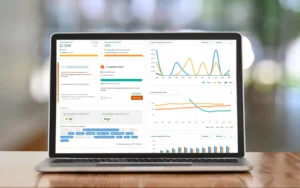
#10 Rightsize and Rationalize Your Portfolio
Rationalization is key to reducing SaaS sprawl by removing applications from your stack, whether by canceling them outright or sunsetting them in lieu of a tool with similar functionality. Rightsizing is similar to rationalization but matches license size to utility, rather than reducing the number of apps.
Implementing both rightsizing and rationalization has several key outcomes:
- More efficient use of licenses
- Smaller SaaS footprint, which equals reduced costs
- Fewer doors for bad actors to enter
- More unified collaboration across the company
#11 Communicate Transparently with the Company
Governance only succeeds when employees understand the “why” behind it. Use transparent communication to build trust, clarify expectations, and drive adoption of approved tools. Regularly update stakeholders on cost savings, security improvements, and new app availability to maintain engagement with the plan.
#12 Measure Program Effectiveness
Track your metrics to validate the impact of your governance practices. Examples of key performance indicators include:
- License utilization rates
- Cost savings and avoidance
- Reduction of applications via rationalization
- Time saved in procurement
- Shadow IT reduction
Measuring these results will help you refine governance policies and demonstrate value to your executive leadership.
The Impact of AI and Emerging Technologies on SaaS Governance
Artificial intelligence and other emerging technologies are transforming how organizations approach SaaS governance in 2025. These advancements offer opportunities for greater efficiency but also introduce new risks that governance frameworks must address.
Key areas where AI and emerging technologies are influencing SaaS governance include:
- Automated license optimization and spend management
- Advanced risk detection and compliance monitoring
- AI-native applications and ethical considerations
- Integration with evolving cloud and security technologies
Automated License Optimization and Spend Management
AI-driven analytics can automatically identify unused licenses, forecast renewals, and suggest cost-saving opportunities. This level of automation reduces manual oversight and helps businesses adapt more quickly to changes in software usage.
Advanced Risk Detection and Compliance Monitoring
Machine learning models can detect unusual patterns that signal potential security or compliance issues. By continuously analyzing app activity, these systems give governance teams an early warning system that strengthens their overall risk posture.
AI-Native Applications and Ethical Considerations
As AI-native tools become increasingly common in enterprise stacks, governance must account for new factors, including algorithmic bias, data usage policies, and vendor transparency. Clear guidelines can ensure these applications are adopted responsibly.
Integration with Evolving Cloud and Security Technologies
Governance cannot operate in isolation. AI and other emerging tools increasingly connect with cloud infrastructure, identity management, and threat detection platforms. Integrating these technologies with SaaS governance policies ensures a consistent approach to risk and efficiency across the entire digital ecosystem.
Strengthen SaaS Governance, Drive Efficiency, Reduce Risk with Zylo
SaaS portfolios will only continue to expand, and without clear governance, the risks grow just as quickly. Implementing the right framework ensures applications are visible, secure, and aligned with business priorities. By combining visibility, AI-driven insights, and consistent policies, companies can reduce waste, enhance compliance, and safeguard sensitive data.
SaaS governance is a strategy for smarter growth and long-term efficiency. Zylo is here to help you get started. Learn more about our SaaS Security and Governance solution, or schedule time with our team for a demo.
SaaS Governance Frequently Asked Questions
What is SaaS governance and why is it important for organizations?
SaaS governance is the framework for managing how subscription-based software is purchased, secured, and measured. It is important because it reduces wasted spend, improves security, and ensures software investments align with business goals.
How is AI impacting SaaS governance?
AI is making governance faster and more precise. Machine learning can detect unused licenses, identify risks, and forecast usage trends. These capabilities help organizations save money, strengthen compliance, and manage their software portfolios more effectively.
What are the key components of a successful SaaS governance framework?
A strong framework includes visibility into the full app portfolio, clear policies for procurement, standardized security reviews, license management, and continuous measurement of results. Together, these components ensure SaaS tools support long-term strategy.
How can effective SaaS governance improve data security and compliance?
How does SaaS governance help manage costs and optimize software usage?
Governance programs monitor app usage and identify opportunities to consolidate overlapping tools. They also ensure license counts match actual demand. The result is reduced waste and a clearer return on software investments.
What tools are recommended for implementing SaaS governance?
SaaS Management Platforms are most effective holistically. These tools provide real-time visibility into app usage, automate renewal tracking, and support compliance monitoring across the organization.
Why do SaaS governance policies fail at some companies?
Policies often fail when they are too complex, poorly communicated, or inconsistently enforced. Success depends on clear guidelines, executive sponsorship, and easy access to approved applications that meet employee needs.
How can IT leaders ensure employees comply with SaaS governance guidelines?
Leaders should combine education with enablement. Providing an application catalog, explaining the benefits of governance, and regularly sharing results helps employees understand why guidelines matter and encourages compliance.

